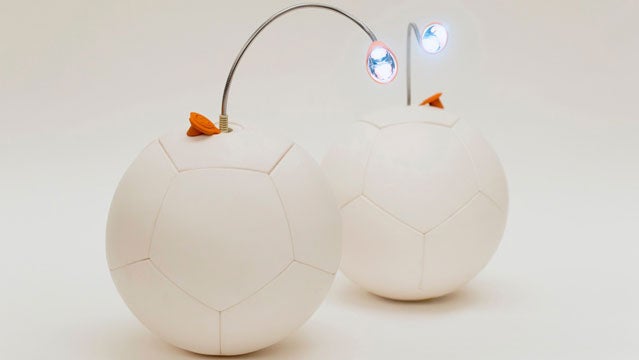Various non-governmental organizations and crafty startups the world over have spent much of the past few years engineering interesting methods and devices to generate small amounts of power as a means for improving health, access to education, and employment in the developing world.

These solutions generally exploit solar power or kinetic energy, say, through hand cranks, to generate light, heat, clean water or electricity. Compared to incumbent sources, such as charcoal or kerosene, these are cleaner and more sustainable.
But it’s hard to make a game out of a solar panel. With that in mind, , a startup that grew out of an undergraduate engineering class at Harvard, has built an energy harvester into a soccer ball. The ball, called the Soccket, weighs one ounce more than a conventional soccer ball.
Here’s how it works: a small pendulum inside the ball swings back and forth as the ball is kicked around, a tiny generator turns that kinetic energy into electricity, which is stored in a small lithium ion battery inside the ball. Thirty minutes of ball juggling equals three hours of light from an LED bulb that plugs directly into the ball.
Through partnerships with corporate sponsors, Uncharted Play is running a number of pilot programs in which the Soccket balls are distributed to resource-poor communities. Kids are taught how the balls work and shown the benefits of using the LED light, compared to burning fuel. This is great, but not enough.
“Right now, the balls are assembled by hand on Long Island,” says Alison Dalton Smith, Uncharted Play’s director of communications. “Production is very slow and iterative and we’ve been producing 550 per week, at the most.” To meet growing demand, the company decided to start a and set a goal of $75,000, which will cover the costs of automating assembly and boosting the research budget. With hours to go, the campaign has garnered more than $87,000.
Smith says Uncharted Play did its homework before launching into crowdfunding and is confident it will meet the spike in demand for the balls that is coming from the campaign. “We have all our ducks in a row,” she said. “We read a lot of tips about what not to do in a Kickstarter campaign.”
The company wants to keep producing the balls domestically, “as long as it is an iterative process,” she says, because any gains they make in production costs by moving assembly to, say, Asia, would be lost as changes are made to the construction of the ball.
NOT QUITE ONE FOR ONE���������� ����������
Like many companies focused on social investment, Uncharted Play considered following the One for One business model popularized by , in which the purchase of one product in the developed world equates to the gift of another of the same product in the developing world. But the production costs of the Soccket ball are too high for this model to work, says Smith. Instead, the company will divert a portion of all proceeds and use them to distribute heavily subsidized Soccket balls, working through NGOs and other partners, in the developing world. People living in energy poverty would not generally be able to afford the ball for more than $10, says Smith. The Kickstarter campaign offers a Soccket ball and LED lamp as an incentive for a donation of $100 or more.
Current pilot programs are underway in South Africa (underwritten by Western Union) and Mexico (underwritten by media company Televisa). Surprisingly, some kids in the United States could benefit from the balls, as well. “My dad works in south Bronx,” says Smith, “And one of his students said that kids who live in homeless shelters, they usually have lights-out at 9 p.m.” A Soccket ball and light could prove handy for them.
Uncharted Play is also creating that is designed not for creating energy but for giving back. The ball has an embedded wireless sensor that tracks movement and uploads the data to the user’s online account. The more the ball moves, the more credits the user generates and these “play points” are translated into real currency in the form of tools or other material goods for social development projects around the world.
New products in the pipeline include a phone charger adapter for the ball, as well as energy-harvesting versions of an American football, a basketball and even a scooter.


